
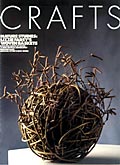
Lizzie
Farey, until recently the chair of the Scottish Basket Makers Association,
came to basket-making via a circuitous route. A foundation course at Canterbury
College of Art, followed by two terms at Cardiff Institute of Higher Education
was time enough to make her realise that she was not quite ready for formal
art education. When she was 27, she watched her sister-in-law making a
baby's cradle, bought two bolts of willow, and began to teach herself
the skills of basket making. She had found a craft that allowed her to
combine her love of nature with her love of art.
'With
baskets,' she explains, 'there is a formula to development - you start
with round ones and then ovals and finally square work. From there I was
able to make virtually anything to commission.' From an early stage she
had no interest in perfection, she wanted the imperfections to show. Although
influenced, initially, by traditional basket making, once she had learned
the basic techniques she became rather dissatisified. Driven by the need
for self-expression she began to develop her own approach, best exemplified
by her exploration of a form of random, non-geometric weaving. Utilitarian
pieces have gradually given way to sculptural forms incorporating a wide
range of native plants.
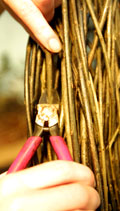
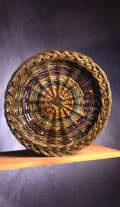
Farey
attended a number of short courses in basket making. At one, in County
Galway, she met the basket maker Joe Hogan, who inspired her to grow her
own willow. She also encountered David Drew. 'At that point I was striving
for technical perfection, but I realised that my baskets were never ever
going to be 'perfect' in the sense that I use natural materials. I knew
that every basket I made had to please me intensely before it was finished,
otherwise it was not worth doing, and David Drew made me see that I had
either to accept that my work was never going to be perfect, or add something
else to it.'
In
her work Farey wants to recreate her intense feelings for the landscape:
'I must capture the experience of being with nature when making a basket'.
This experience has also encouraged her to develop a knowledge of the
plants she uses. She grows more than 20 varieties of willow. Her favourite
willow is the tall and slender Salix Purpurea, her favourite variety the
blue-green Brittany Blue, which she combines with other native plants.
She has learnt when to collect them - knowing, for example, that the new
growth of larch must be gathered between December and March. Local farmers
and landowners now encourage her to collect material from their hedgerows
before they are trimmed.
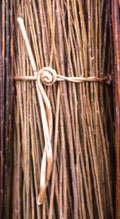
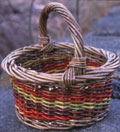
At
a recent exhibition at The Broughton Gallery near Biggar, she showed beautifully-made
baskets in contrasting layers of rainbow-coloured dogwood and willow.
These rich bands of colour might be artificial, but such is the colour
range found in the bark of the unstripped willow that Farey uses only
one dye - indigo.
Farey
also exhibited new randomly woven basket
forms. These are made of intertwined twigs and
stems, some still retain their fruit or seed heads
such as beech mast, hops or pussy willow. Birch,
hazel, heather, larch, bog myrtle, sphagnum moss
and wild raspberry impart a Scottish flavour and sometimes even a fragrance to the work.
forms. These are made of intertwined twigs and
stems, some still retain their fruit or seed heads
such as beech mast, hops or pussy willow. Birch,
hazel, heather, larch, bog myrtle, sphagnum moss
and wild raspberry impart a Scottish flavour and sometimes even a fragrance to the work.
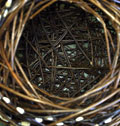
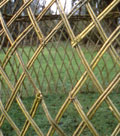
Her
most recent works are two large-scale pieces
which she made with fellow basket maker Trevor Leat. The first is a living willow 'house' (in reality more of
a folly), thatched with rushes, built on private land
near Castle Douglas. The second, a ring-shaped
seat, 3.65 metres in diameter, using green-willow
side stakes and weavers, was made for the
grounds of Castle Douglas Library.
which she made with fellow basket maker Trevor Leat. The first is a living willow 'house' (in reality more of
a folly), thatched with rushes, built on private land
near Castle Douglas. The second, a ring-shaped
seat, 3.65 metres in diameter, using green-willow
side stakes and weavers, was made for the
grounds of Castle Douglas Library.
Lizzie
Farey is self-effacing about her craft:
'Basket making,' she says, 'is perhaps the oldest
craft in the world, yet beginners can make
a basket within the first day'.
'Basket making,' she says, 'is perhaps the oldest
craft in the world, yet beginners can make
a basket within the first day'.
